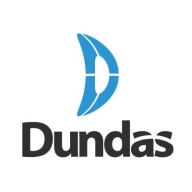

Dundas Dashboard and Splunk Cloud Platform compete in business intelligence and data analytics. While Dundas Dashboard is favored for its pricing and support, Splunk Cloud Platform justifies its higher investment with superior feature offerings.
Features: Dundas Dashboard offers interactive dashboards and extensive customization options. It supports a customizable UI and provides easy connectivity to various data sources. Splunk Cloud Platform is recognized for log aggregations, dashboarding, and robust scalability. It also offers powerful data analysis capabilities and an intuitive search interface.
Room for Improvement: Dundas Dashboard could enhance its data handling capabilities and scalability. Improvements in integration with larger enterprise systems would be beneficial. Splunk Cloud Platform may need to work on reducing initial setup costs and simplifying extensive feature complexity for new users.
Ease of Deployment and Customer Service: Dundas Dashboard features a straightforward deployment model with reliable support aimed at easy integration. Splunk Cloud Platform offers efficient deployment with comprehensive documentation and customer service, perceived as more robust, appealing to larger enterprises.
Pricing and ROI: Dundas Dashboard presents a cost-effective setup focusing on quick ROI through accessible pricing. Splunk Cloud Platform involves higher costs but delivers substantial ROI through its analytics capabilities. Enterprises often find this investment worthwhile for managing complex data.
Premium support is costly and may not always provide a satisfactory experience.
Splunk Cloud Platform needs improvement in its security offerings, specifically in cybersecurity.
Splunk Cloud is considered too expensive, with its two product offerings both being costly.
The most valuable feature of Splunk Cloud Platform is its robustness and ability to ingest logs.

Dashboards provide a central location for users to access, interact and analyze up-to-date information so they can make smarter, data-driven decisions. Good dashboard software enables you to monitor and measure performance and metrics in real-time and on the go. You can visualize and analyze data and focus on Key Performance Indicators (KPIs) from across the organization on a dashboard, helping you gain valuable insight and drive quick and accurate decision making.
Splunk Cloud Platform is widely used for log management, security monitoring, application performance monitoring, troubleshooting, data aggregation, and IT operations. It centralizes logs from numerous sources, enabling detailed analysis, incident detection, and effective dashboard creation.
Companies across various industries leverage Splunk Cloud Platform for cybersecurity, compliance, user activity monitoring, and alerts. It helps in managing cloud environments, optimizing data storage costs, and enhancing customer insights with effective data visualization. The platform's robust capabilities include customizable reporting, flexible log sending, powerful search features, and seamless integration with other systems. Users monitor multiple environments and platforms effortlessly with the cloud infrastructure maintained by Splunk. Despite its advantages, users find the pricing steep, support ineffective, and encounter performance issues with large data volumes. Integration challenges, limited training resources, and insufficient documentation also pose concerns.
What are the most important features of Splunk Cloud Platform?Splunk Cloud Platform is implemented across industries including finance, healthcare, retail, and technology. Organizations use it to enhance cybersecurity measures, meet compliance requirements, monitor user activities, and issue automated alerts. In finance, it assists in fraud detection and compliance. In healthcare, it ensures data security and regulatory adherence. Retailers use it for customer behavior analysis and performance monitoring, while technology companies benefit from its troubleshooting and log management capabilities. Despite its powerful features, companies face challenges with pricing, support, and integration that require consideration during implementation.
We monitor all Data Visualization reviews to prevent fraudulent reviews and keep review quality high. We do not post reviews by company employees or direct competitors. We validate each review for authenticity via cross-reference with LinkedIn, and personal follow-up with the reviewer when necessary.